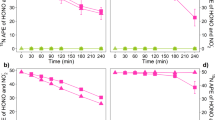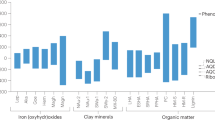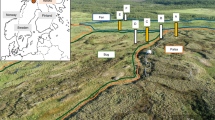Abstract
THE deleterious effect of chlorofluorocarbons on stratospheric ozone has led to international cooperation to end their use1– 3. The search for acceptable alternatives has focused on hydrofluorocarbons (HFCs) or hydrochlorofluorocarbons (HCFCs) which are attractive because they have relatively short atmospheric residence times4. HFCs and HCFCs are attacked by tropospheric hydroxyl radicals, leading to the formation of trifluoroacetate (TFA)5. Most of the atmospheric TFA is deposited at the Earth's surface6, where it is thought to be highly resistant to bacterial attack5. Therefore, use of HCFCs and HFCs may lead to accumulation of TFA in soils, where it could prove toxic or inhibitory to plants and soil microbial communities5,7. Although little is known about the toxic-ity of TFA, monofluoroacetate, which occurs at low levels in some plants8 and which is susceptible to slow attack by aerobic soil microbes9, is known to be acutely toxic10–13. Here we report that TFA can be rapidly degraded microbially under anoxic and oxic conditions. These results imply that significant microbial sinks exist in nature for the elimination of TFA from the environment. We also show that oxic degradation of TFA leads to the formation of fluoroform, a potential ozone-depleting compound with a much longer atmospheric lifetime than the parent compounds.
This is a preview of subscription content, access via your institution
Access options
Subscribe to this journal
Receive 51 print issues and online access
$199.00 per year
only $3.90 per issue
Buy this article
- Purchase on Springer Link
- Instant access to full article PDF
Prices may be subject to local taxes which are calculated during checkout
Similar content being viewed by others
References
Molina, M. & Rowland, F. S. Nature 249, 810–812 (1974).
Prather, M. J. & Watson, R. T. Nature 344, 729–734 (1992).
Global Ozone Research and Monitoring Project (Rep. No. 20, World Meteorological Organization, Geneva, 1989).
Nimitz, J. S. & Scaggs, S. R. Envir. Sci. Technol. 26, 739–743 (1992).
Franklin, J. Chemosphere 27, 1565–1601 (1993).
Rodriguez, J. M., Ko, M. K. W., Sze, N. D. & Heisey, C. W. Proc. AFEAS Workshop on Atmospheric Wet and Dry Deposition of Carbonyl and Haloacetyl Halides 25–32 (AFEAS, Washington DC, 1992).
Ingle, L. M. Proc. West Virginia Acad. Sci. 40, 1–11 (1968).
Oelrichs, P. B. & McEwan, T. Nature 190, 808–809 (1961).
Wong, D. H., Kirkpatrick, W. E., King, D. R. & Kinnear, J. E. Soil Biol. Biochem. 24, 833–838 (1992).
Kun, E. Citric Acid Cycle, Control and Compartmentation (ed. Lowenstein, J. M.) 279–339 (Dekker, New York, 1969).
Bong, C. L., Cole, A. J. L., Walker, J. R. L. & Peters, J. A. Soil Biol. Biochem. 11, 13–18 (1979).
Notman, P. N.Z. J. Entomol. 12, 67–71 (1989).
Cappenberg, T. E. & Prins, R. A. Antonie van Leeuwenhoek 40, 457–469 (1974).
Lovley, D. R. & Woodward, J. C. Envir. Sci. Technol. 26, 925–929 (1992).
Oremland, R. S., Miller, L. G. & Strohmaier, F. E. Envir. Sci. Technol. 28, 514–520 (1994).
Oremland, R. S., Marsh, L. M. & Polcin, S. Nature 296, 143–145 (1982).
Oremland, R. S. & Culbertson, C. W. Nature 356, 421–423 (1992).
Miller, L. G., Coutlakis, M. D., Oremland, R. S. & Ward, B. B. Appl. Envir. Microbiol. 59, 2457–2464 (1993).
Oremland, R. S. & Capone, D. G. Adv. microb. Ecol. 10, 285–383 (1988).
Oremland, R. S. in Biology of Anaerobic Microorganisms (ed. Zehnder, A. J. B.) 641–706 (Wiley, New York, 1988).
Oremland, R. S. & Polcin, S. Appl. Envir. Microbiol. 44, 1270–1276 (1982).
Christensen, D. & Blackburn, T. H. Mar. Biol. 7, 113–119 (1982).
Mohn, W. W. & Tiedje, J. M. Microbiol. Rev. 56, 482–507 (1992).
Londry, K. L. & Fedorak, P. M. Arch. Microbiol. 160, 137–143 (1993).
Oremland, R. S. & Zehr, J. P. Appl. Envir. Microbiol. 52, 1031–1036 (1986).
Taylor, B. F., Hearn, W. L. & Pincus, S. Arch. Microbiol. 122, 301–306 (1979).
Bauchop, T. J. Bacteriol. 94, 171–175 (1967).
Wood, J. M., Kennedy, F. S. & Wolfe, R. S. Biochemistry 7, 1707–1713 (1968).
Bouwer, E. J. & McCarty, P. L. Appl. Envir. Microbiol. 45, 1295–1299 (1983).
Bouwer, E. J. & McCarty, P. L. Envir. Sci. Technol. 45, 1286–1294 (1983).
Oremland, R. S. & Culbertson, C. W. Appl. Envir. Microbiol. 58, 2983–2992 (1992).
DeFlaun, M. F., Ensley, B. D. & Steffan, R. J. Biotechnology 10, 1576–1578 (1992).
Oremland, R. S. Appl. Envir. Microbiol. 42, 122–129 (1981).
Culbertson, C. W., Zehnder, A. J. B. & Oremland, R. S. Appl. Envir. Microbiol. 41, 396–403 (1981).
Culbertson, C. W., Strohmaier, F. E. & Oremland, R. S. Origins Life Evol. Biosphere 18, 397–407 (1988).
Author information
Authors and Affiliations
Rights and permissions
About this article
Cite this article
Visscher, P., Culbertson, C. & Oremland, R. Degradation of trifluoroacetate in oxic and anoxic sediments. Nature 369, 729–731 (1994). https://doi.org/10.1038/369729a0
Received:
Accepted:
Issue Date:
DOI: https://doi.org/10.1038/369729a0
This article is cited by
-
Distribution characteristics of trifluoroacetic acid in the environments surrounding fluorochemical production plants in Jinan, China
Environmental Science and Pollution Research (2020)
-
Fluoroacetate in plants - a review of its distribution, toxicity to livestock and microbial detoxification
Journal of Animal Science and Biotechnology (2017)
-
Biodegradation and biotransformation of organofluorine compounds
Biotechnology Letters (2010)
-
Metabolism of fluoroorganic compounds in microorganisms: impacts for the environment and the production of fine chemicals
Applied Microbiology and Biotechnology (2009)
-
Sulfur geochemistry of hydrothermal waters in Yellowstone National Park, Wyoming, USA. III. An anion-exchange resin technique for sampling and preservation of sulfoxyanions in natural waters
Geochemical Transactions (2003)
Comments
By submitting a comment you agree to abide by our Terms and Community Guidelines. If you find something abusive or that does not comply with our terms or guidelines please flag it as inappropriate.



